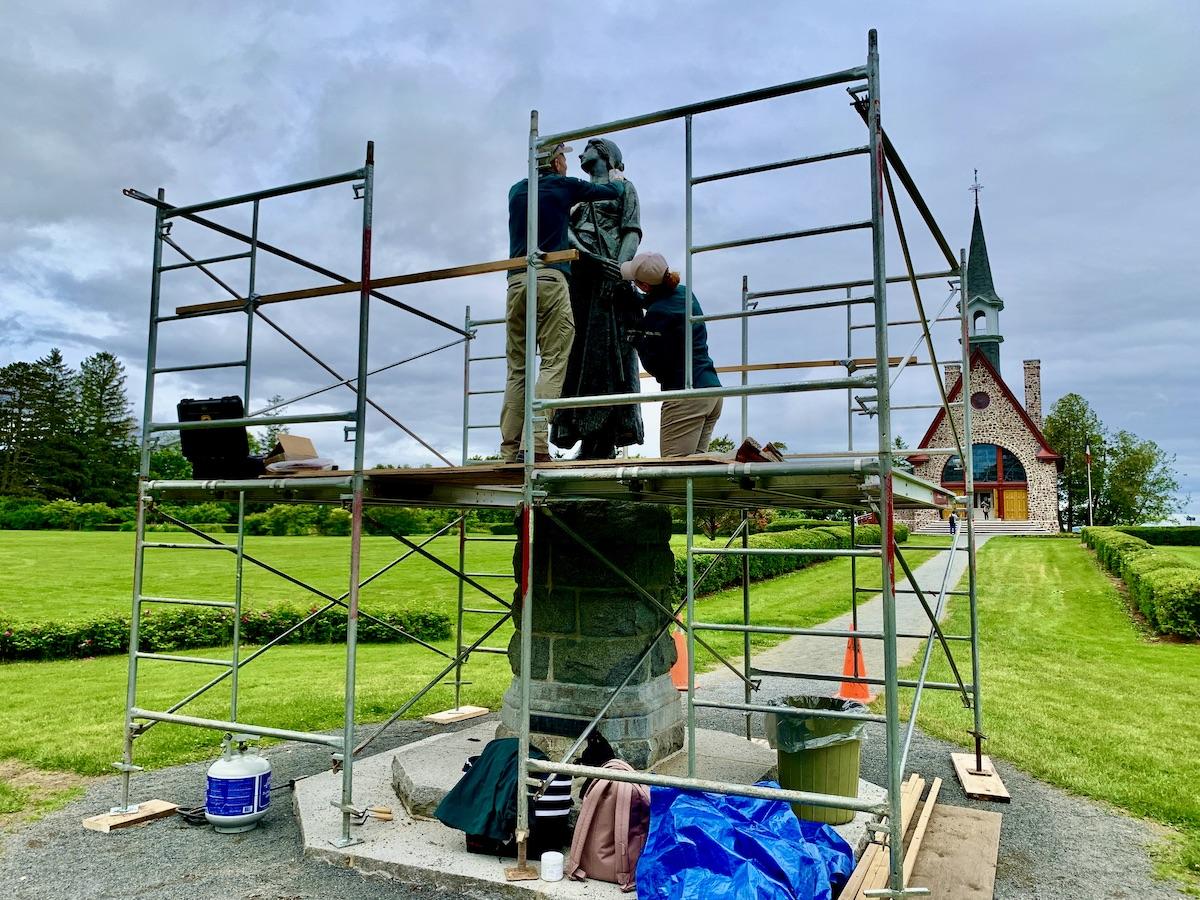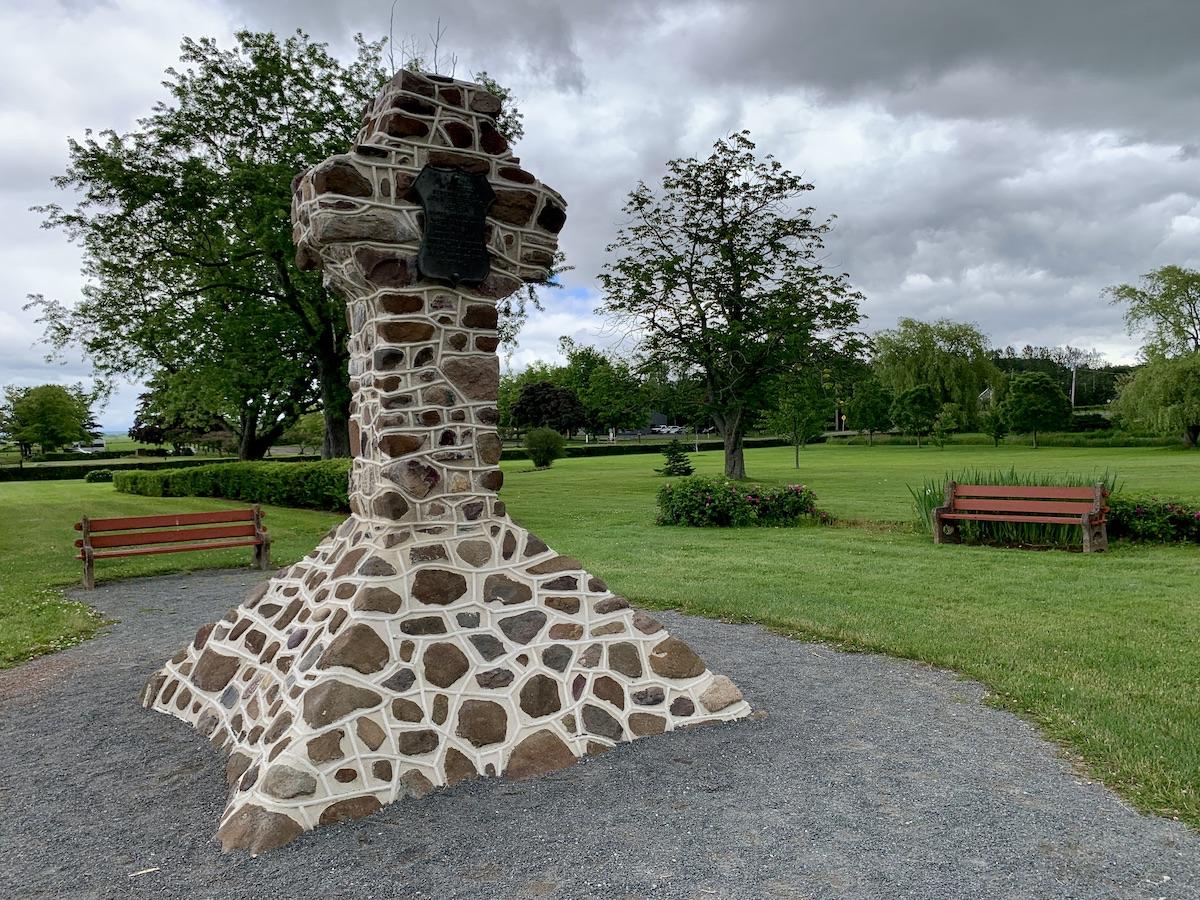
Parks Canada conservators Antoine Pelletier and Carolyn Savage work on the Evangeline statue at Grand-Pré National Historic Site/Jennifer Bain
For 102 years, a statue of Evangeline, the fictional heroine from a poignant 1847 poem, has drawn people to the rural part of Nova Scotia that is the most significant memorial to the tragic deportation of the Acadian people.
Evangeline stands before me as a bronze statue by Québécois sculptor Henri Hébert, who created a variation on an earlier design of his father, sculptor Louis-Philippe Hébert. Unveiled by the Dominion Atlantic Railway on July 29, 1920 to boost train tourism, Evangeline, in the words of Parks Canada, “seems to perpetually grieve for her lost homeland of Acadie.”
I can’t get a good look at her today at Grand-Pré National Historic Site because conservators Antoine Pelletier and Carolyn Savage from Parks Canada’s national conservation team are working on her and have set up scaffolding and orange pylons.
“Right now, we are doing mechanical preparations of the surface,” explains Pelletier, who uses plastic scrapers to avoid scratching the bronze patina. Tomorrow, Evangeline will get a new layer of wax that should protect against corrosion and graffiti.
“We want a very thin layer of wax. Too thin and it will flake off. We need just the right amount. This is where the science comes in,” allows Pelletier. “Before the end of the day tomorrow at four o’clock, she should be done and ready to enjoy for another five years. It’s going to be an even sheen.”
Pleased to share insight into his work, Pelletier adds that “usually, if you can keep it up, a bronze sculpture can last for centuries.”
It’s entirely possible that this “heroic size” sculpture — set in front a memorial church — will spend centuries helping tell an important story. “Evangeline is so important to the development of this region,” Mitchell Legg, acting supervisor of visitor experience at Grand-Pré, says during a tour.

Eight oTENTiks have been added to Grand-Pré so visitors can sleep over at the national historic site/Jennifer Bain
For millennia, the Mi’kmaq people lived, hunted and fished in this fertile Annapolis Valley area an hour from Halifax. The Acadians were the first European pioneers to settle in the region in the 1680s and they formed trade alliances and friendships with the Mi’kmaq.
Faced with the world’s highest tides at the Bay of Fundy, the Acadians erected an ingenious dyke and drainage system that converted salt marshes into agricultural land and allowed farms, orchards and villages to flourish.
By 1755, about 2,000 Acadians lived in the area. But they insisted on staying neutral instead of swearing an unconditional oath of allegiance to the Crown while Britain and France fought over Acadia. On the eve of the Seven Years War, British forces deported them throughout the American colonies, England and France as part of a large deportation of 10,000 people. Some escaped, but many died in shipwrecks and of disease and starvation.
British authorities finally allowed Acadians to return to Nova Scotia in 1764. But they were forced to settle elsewhere in Nova Scotia, New Brunswick, Prince Edward Island and Quebec because their former lands had been granted to New England settlers known as “Planters.”

American writer Henry Wadsworth Longfellow is commemorated at Grand-Pré for his epic poem Evangeline/Jennifer Bain
In 1847, Evangeline entered the picture.
American writer Henry Wadsworth Longfellow’s epic poem Evangeline, A Tale of Acadie was published that year detailing the love story of the fictional Evangeline and Gabriel who were separated by the expulsion. The poem struck a nerve, raising global awareness about the tragic history of the Acadians and becoming part of the American school curriculum for generations. Evangeline quickly became a symbol of the perseverance of the Acadian people in the face of adversity.
By 1871, steamship and rail service from New England to Nova Scotia had begun to bring tourists to the “Land of Evangeline,” Parks Canada reports. “The combination of an alluring romantic tale of love and loss and a heavenly landscape inspired a new class of ‘tourists’ to travel to Nova Scotia.”

This stone cross is named for John Frederic Herbin who first preserved this land as a memorial to Acadians/Jennifer Bain
Jump ahead to 1907 and Nova Scotia writer/historian John Frederic Herbin bought the site of the church where the deportation order was first given and established Grand-Pré Park as a memorial to the Acadians. He erected a stone cross to mark the cemetery, but sold the park to the Dominion Atlantic Railway a decade later on the assurance that the church site be deeded to the Acadian people.
In 1920, the railway unveiled the Evangeline statue near the park entrance and close to the train station as many businesses appropriated the fictional heroine’s image to sell everything from pop and chocolates to car dealerships and funeral homes.
Grand-Pré was transferred by Dominion Atlantic to the federal government in 1957. It opened as a historic park in 1961 and became a national historic site in 1982 because it commemorates the 1755 deportation of the Acadians, was a center of Acadian activity from 1682 to 1755, and commemorates an ongoing Acadian attachment to the heart of their ancestral homeland.

Inside the memorial church behind the Evangeline statue, a powerful stained glass window commemorates the 1755 Acadian deportation/Jennifer Bain
The 26.57-hectare (65.6-acre) national historic site is currently home the Evangeline statue and a Longfellow monument, as well as the Herbin cross, a memorial church built in 1922 with funds from the Acadian diaspora, the spot that was once an Acadian cemetery, a blacksmith’s shop and well, Victorian gardens, apple orchard, French willows and a visitor center full of art and artifacts.
Grand-Pré drew nearly 40,000 visitors in 2019 before the pandemic, and its season runs mid-May to mid-October, although the grounds are open year-round. Eight oTENTiks (a tent-cabin hybrid) were installed in 2020 to attract campers. Public input is being collected until Aug. 5 on a draft management plan that will guide site decisions and actions for the next decade.
Parks Canada has pinpointed three key strategies — to become “an attractive, world-class historic site,” to be “a place of remembrance for the Acadian community and a place of learning for all,” and to be “a place for Mi’kmaq, partners and collaborators working in synergy towards a shared vision.”

Grand-Pré National Historical Site is part of the wider Landscape of Grand-Pré UNESCO World Heritage Site and this "view park" is nearby/Jennifer Bain
The busy national historic site may draw the crowds, but it’s actually only about four per cent of the 1,300-hectare (3,212-acre) Landscape of Grand Pré UNESCO World Heritage Site.
“The landscape is an exceptional example of the adaptation of the first European settlers to the conditions of the North American Atlantic coast,” said UNESCO in making the 2012 designation. “The site — marked by one of the most extreme tidal ranges in the world, averaging 11.6 m — is also inscribed as a memorial to Acadian way of life and deportation, which started in 1755, known as the Grand Dérangement.”
Around Grand-Pré, agritourism is booming and the 110-kilometre (68-mile) Harvest Moon Trailway is attracting cyclists and hikers to the Annapolis Valley.

A view of the back of the Evangeline sculpture as the Parks Canada conservators break for lunch/Jennifer Bain
It's hard to believe that the Evangeline statue turned 100 in 2020. Since the statue was noticeably leaning, its stone base was overhauled last year to prevent water pooling and infiltration of pests, improve ventilation and strengthen the structure.
As Parks Canada explains, outdoor bronze statues must be regularly cleaned because they get covered in pollen, dirt and bird droppings and become home to insects and spiders.
For this year’s touch-up to Evangeline herself, I missed seeing conservators assess the statue’s surface, looking for weakness or cracks. I arrived on the day they cleaned her with a pressure washer and then soap and water to remove any old coatings from previous treatments. The surface would then be heated with a propane torch so a custom blend of hard waxes could be applied with a brush. Finally, the statue cools and then conservators buff Evangeline with a lint-free cloth.

This sculpture of an Acadian family sent into exile was commissioned to mark the 250th anniversary of the deportation/Jennifer Bain
As the conservators break for lunch, and before I have a Parks Canada "Perfect Picnic" (catered from the Church Brewing Co. in nearby Wolfville), I take a final look at Evangeline. At the Longfellow monument, I read how his poem came out as "strong feelings of Acadian identity were developing, as was their determination to survive as a people."
Just outside the visitor center, I get an unobstructed view of the sculpture of a four-member Acadian family that symbolizes the experiences of all those "that were forcibly uprooted from their homes and sent into exile to face an unknown future in foreign lands." Created by Quebec artists Jules LaSalle and André Fournelle to mark the 250th anniversary of the tragic deportations, this sculpture was unveiled Sept. 3, 2006 and originally placed on a nearby hill.
But there wasn't a proper trail to it and it was near poisonous wild parsnip, so this sprawling sculpture — like the Acadians it depicts — was forced to move. It's still settling into its new home on gravel in front of a patch of forest.

 Support Essential Coverage of Essential Places
Support Essential Coverage of Essential Places




Add comment